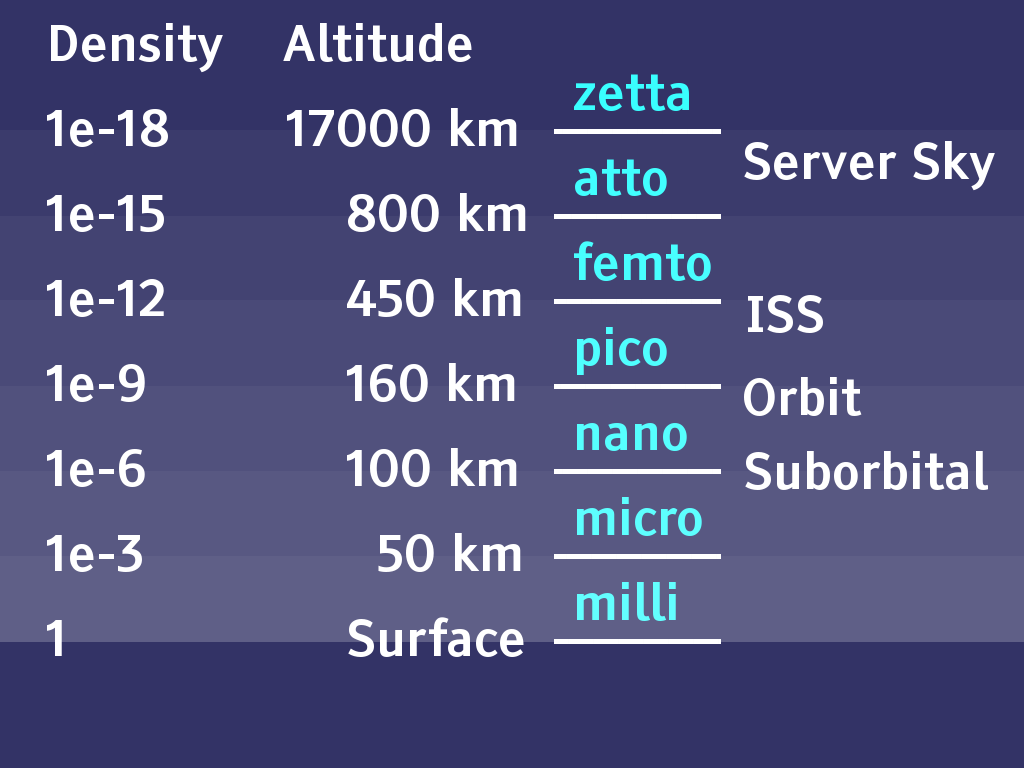|
Size: 2618
Comment:
|
Size: 2638
Comment:
|
| Deletions are marked like this. | Additions are marked like this. |
| Line 2: | Line 2: |
| === Density === | [[http://server-sky.com/Density]] |
| Line 4: | Line 4: |
| {{attachment:dens1.png||width=512}}[[attachment:dens1.png|dens1.png}} | {{attachment:dens1.png||width=512}}[[attachment:dens1.png|dens1.png]] |
| Line 14: | Line 15: |
| || femto || 1e-14 || || 778 km altitude || Iridium || | |
| Line 15: | Line 17: |
| || nano || 1.2e-09 || || 160 km altitude || useful low earth orbits || | || nano || 1.2e-09 || || 160 km altitude || temporary low earth orbits || |
| Line 21: | Line 23: |
| || Mega || ≈ 1e6 || 3.6 MBar || Center of Earth || ideal gas density at pressure || |
A Density Scale
Server Sky will deploy at 6411 km altitude. Gas density at that altitude is 6E-18 kg/m2, mostly hydrogen. That is 5E-18 times smaller than air density at the surface; it is difficult to comprehend just how tenuous the exosphere is, so here is a density scale. The densities below assume average solar activity, F107 = 150 , averaged over the day, on the equator, at the equinox .
"zone" |
density kg/m3 |
pressure |
||
zepto |
2e-21 |
|
|
interstellar space "average" |
zepto |
1e-20 |
|
|
interplanetary space 1 A.U. |
atto? |
? |
|
35786 km altitude |
geosynchronous orbit |
atto |
6e-18 |
|
6411 km altitude |
m288 server sky |
atto |
3e-17 |
|
|
beamline Large Hadron Collider |
femto |
1e-15 |
|
1250 km altitude |
lowest sustainable solar sail |
femto |
1e-14 |
|
778 km altitude |
Iridium |
pico |
2e-12 |
|
410 km altitude |
International Space Station |
nano |
1.2e-09 |
|
160 km altitude |
temporary low earth orbits |
micro |
6.8e-07 |
|
100 km altitude |
"edge of space", suborbitals |
micro |
8.5e-06 |
|
85 km altitude |
drag zone for suborbital |
milli |
1.1e-03 |
|
50 km altitude |
|
|
1.2 |
1.01 Bar |
0 km altitude |
Sea level |
Kilo |
≈ 1e3 |
1.1 KBar |
|
Deepest Ocean |
The air is too dense at ISS altitudes (in the pico zone) to experiment with server sky - thinsats must be in orbit long enough to test maneuvering and to be observed from the earth, in the femto circular orbit zone or higher. Low earth orbits in the nano zone have a million times as much drag, and a suborbital in the micro zone has a billion times as much density as the femto zone.
A suborbital falling for 100 seconds plunges at more than 900 meters per second, and descends almost 50 kilometers, into the "milli zone". A single turn and stop thinsat maneuver takes 300 seconds. Quite impractical for thinsat testing, even inside a vacuum chamber inside the suborbital.

